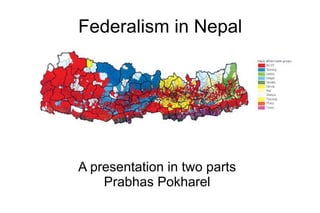
Federalism in Nepal, 3/20 presentation by Prabhas
- 1. Federalism in Nepal A presentation in two parts Prabhas Pokharel
- 2. What is Federalism? Federalism is a system of Government in which ● Certain powers are exercised by levels of government below the national ● Those powers are constitutionally guaranteed ● Those powers do not depend on the national government.
- 3. Examples The United States. India, Australia, Switzerland, Canada, South Africa, Nigeria, Ethiopia, …
- 4. Why federalism in Nepal? (1/4) The Interim Constitution says so: 33. RESPONSIBILITIES OF THE STATE The State shall have the following responsibilities: (d) to carry out an inclusive, democratic and progressive restructuring of the State by eliminating its existing form of centralised and unitary structure in order to address the problems related to women, Dalits, indigenous tribes [Adivasi Janajati], Madhesis, oppressed and minority communities and other disadvantaged groups, … 138. PROGRESSIVE RESTRUCTURING OF THE STATE (1) To bring an end to discrimination based on class, caste, language, gender, culture, religion and region by eliminating the centralised and unitary form of the state, the state shall be made inclusive and restructured into a progressive, democratic federal system.
- 5. Why federalism in Nepal? (2/4) (..)
- 6. Why federalism in Nepal? (3/4) In a UNDP coference discussion around federalism in Nepal, here were the main arguments laid out: Domination of the country from Kathmandu (excessive ● centralism), ●Domination of the country by a limited group (caste domination), ●Discrimination on caste/ethnic lines ● Failure to meet the needs of the mass of the people.
- 7. Why federalism in Nepal? (4/4) Mainly it is a way of Empowering communities and regions marginalized by ● centralization of power in Nepal
- 8. Nepal today Unitary (ie, not federal) Divided into “ developmental districts” for administrational ease (Power from center; no elections locally, etc)
- 9. Demand for federalism is there The question is: how do you make states?
- 10. (1) Ethnic federalism ..
- 11. (2) Based on “geographic” and “economic viability” Couldn't find a map sorry. (Example: Harka Gurung. Proposes taking current 75 districts, reducing them to 25.)
- 13. Demands of ethnic federalism Gives Cultural communities ● Means to develop their language ●Protect religion ●Take affirmative action in favor of disadvantaged members ●Promote regional parties ●Build political standing to negotiate with center / other federal subunits .. A road to empowerment
- 14. Who wants this? Made by ●Limbus, Rais, Tamangs, Gurungs, Magars, Tharus, other Madhesi groups ●Tamangs have demanded “ areas of historical Tamang occupation” ●Some Madhesi groups have demanded “ one Madhesh” ●Other Madheshi groups demand 2-3 Madheshi states, often based on language
- 15. A note here Pitamber Sharma, who collated geo-ethnic info “ Sharma's answer is that it is possible to demarcate ethnic provinces, but no ethnic group will have a majority in any one of them. Nepal's future federal units must, by definition, be multi-ethnic and multi-linguistic and not regions exclusive to one community who promote a vision of ethnic purity that likely never existed.”
- 16. Plans Many exist. ●Maoists have only concrete one as political party. Mainly focus on how to divide; how many states, etc.
- 17. The arguments against federalism (1/3) Danger of national disintegration, esp if federalism in along ethnic lines ● The example of Yugoslavia ● People's ethnic ties may be stronger than ties to their country ● Globally, more of a concern with very few states (like Pakistan, few others)
- 18. The arguments against federalism (2/3) Efficiency ●Nepal is too small to be divided ●Cost of governance under federalism will be high ●Economic growth should be main concern; federalism doesn't focus on it
- 19. The arguments against federalism (3/3) Its going to be tough New minorities ● ●Can't create equal states ●.. ● (we'll come back to this in part 2)
- 20. End of Part 1. Questions ?
- 21. Part 2: The issues to be dealt with 1. Levels of Governments and Number of Units - How many states? - How many levels of government?
- 22. Part 2: The issues to be dealt with 2. Division of Power b/w State and Nation - Some are federal responsibilities (big infrastructure) - Some are state responsibilities (eg. Primary ed) - Some are concurrent (eg. college ed)
- 23. Part 2: The issues to be dealt with 2b. State – State negotiation rules What if Tamangsaling doesn't want Newa to dump trash / get water.
- 24. Part 2: The issues to be dealt with 3. Boundaries, Mergers, Creation of New Units - When and how can new units be created? Who decides? - Can't be too hard (= war); Can't be too easy (= too much splitting/merging)
- 25. Part 2: The issues to be dealt with 4. Constitutions: One or Many - Does each state have own constitution, or is it a central one?
- 26. Part 2: The issues to be dealt with 5. Independent Institutions ? - Judicial (?) - Anti-corruption commission (?) - What else (?)
- 27. Part 2: The issues to be dealt with 6. The Second Chamber - Like the Senate here - Representation by state (like US). By population, but each state at least one (India). By ethnicity (Ethiopia). - People elect directly (US). States nominate.
- 28. Part 2: The issues to be dealt with 7. The new minorities - All places will have minorities - How do you make sure their rights are protected?
- 29. Part 2: The issues to be dealt with 8. Resources Allocation - Each state not as resourceful - Mechanisms to distribute resources on federal level?
- 30. Part 2: The issues to be dealt with 9... There are more.
- 31. FINALLY The aim is to empower communities. Federalism alone won't do it.